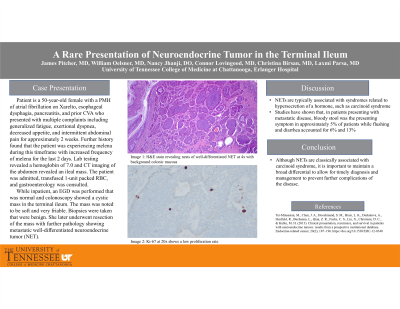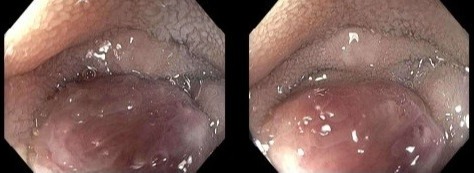Sunday Poster Session
Category: Small Intestine
P1308 - A Rare Presentation of Neuroendocrine Tumor in the Terminal Ileum
Sunday, October 22, 2023
3:30 PM - 7:00 PM PT
Location: Exhibit Hall

Has Audio

James Pitcher, MD
University of Tennessee HSC College of Medicine Chattanooga
Chattanooga, Tennessee
Presenting Author(s)
James Pitcher, MD, William K. Oelsner, MD, Laxmi Parsa, MD, Nancy Jhanji, DO, Connor Lovingood, MD, Christopher Adams, DO, MS, BS
University of Tennessee HSC College of Medicine Chattanooga, Chattanooga, TN
Introduction: Neuroendocrine tumors (NETs) are a subset of malignancies that arise from the neuroendocrine system. These tumors often originate in the gastrointestinal tract. Depending on the functional status and their origin, these tumors can induce symptoms related to the neuroendocrine cells from which they arose. The most notable is carcinoid syndrome, seen in tumors that originate from the embryonic midgut due to the secretory properties of these neuroendocrine cells. Symptoms associated with carcinoid syndrome include severe diarrhea, flushing, and right-sided valvular heart disease.
Although development of typical carcinoid syndrome is rare, the most common presenting symptoms for these patients are severe diarrhea and flushing. Nonfunctional NETs, or those that do not cause fulminant carcinoid syndrome, may initially present as small bowel obstruction (SBO). This case will demonstrate a patient with an atypical presentation of NET and findings on colonoscopy that did not appear to be malignant.
Case Description/Methods: Patient is a 50 year old female with a history of atrial fibrillation on Xarelto, esophageal dysphagia, and pancreatitis who presented with multiple complaints including fatigue, exertional dyspnea, decreased appetite, and intermittent abdominal pain for approximately 2 weeks. She denied any recent diarrhea or flushing. Further history found that the patient was experiencing melena during this timeframe with increased frequency of melena for the last 2 days. Labs revealed a hemoglobin of 7.0 and CT imaging showed mass-like thickening of the terminal ileum.
While inpatient, an EGD was performed that was normal. Colonoscopy showed a subtle mucosal abnormality in the terminal ileum that was smooth, non-circumferential, had increased vasculature, and did not appear malignant. There was no active bleeding. Biopsies were taken that were benign. She later underwent resection of the mass with further pathology showing metastatic well-differentiated neuroendocrine tumor.
Discussion: Although neuroendocrine tumors are typically associated with diarrhea and flushing, other symptoms can be seen on presentation. Though this patient presented with melena and her colonoscopy findings revealed and atypical mass without malignant features, she was found to have NET. In such cases, it is important to maintain a broad differential to allow for timely diagnosis and management to prevent further complications of the disease.

Disclosures:
James Pitcher, MD, William K. Oelsner, MD, Laxmi Parsa, MD, Nancy Jhanji, DO, Connor Lovingood, MD, Christopher Adams, DO, MS, BS. P1308 - A Rare Presentation of Neuroendocrine Tumor in the Terminal Ileum, ACG 2023 Annual Scientific Meeting Abstracts. Vancouver, BC, Canada: American College of Gastroenterology.
University of Tennessee HSC College of Medicine Chattanooga, Chattanooga, TN
Introduction: Neuroendocrine tumors (NETs) are a subset of malignancies that arise from the neuroendocrine system. These tumors often originate in the gastrointestinal tract. Depending on the functional status and their origin, these tumors can induce symptoms related to the neuroendocrine cells from which they arose. The most notable is carcinoid syndrome, seen in tumors that originate from the embryonic midgut due to the secretory properties of these neuroendocrine cells. Symptoms associated with carcinoid syndrome include severe diarrhea, flushing, and right-sided valvular heart disease.
Although development of typical carcinoid syndrome is rare, the most common presenting symptoms for these patients are severe diarrhea and flushing. Nonfunctional NETs, or those that do not cause fulminant carcinoid syndrome, may initially present as small bowel obstruction (SBO). This case will demonstrate a patient with an atypical presentation of NET and findings on colonoscopy that did not appear to be malignant.
Case Description/Methods: Patient is a 50 year old female with a history of atrial fibrillation on Xarelto, esophageal dysphagia, and pancreatitis who presented with multiple complaints including fatigue, exertional dyspnea, decreased appetite, and intermittent abdominal pain for approximately 2 weeks. She denied any recent diarrhea or flushing. Further history found that the patient was experiencing melena during this timeframe with increased frequency of melena for the last 2 days. Labs revealed a hemoglobin of 7.0 and CT imaging showed mass-like thickening of the terminal ileum.
While inpatient, an EGD was performed that was normal. Colonoscopy showed a subtle mucosal abnormality in the terminal ileum that was smooth, non-circumferential, had increased vasculature, and did not appear malignant. There was no active bleeding. Biopsies were taken that were benign. She later underwent resection of the mass with further pathology showing metastatic well-differentiated neuroendocrine tumor.
Discussion: Although neuroendocrine tumors are typically associated with diarrhea and flushing, other symptoms can be seen on presentation. Though this patient presented with melena and her colonoscopy findings revealed and atypical mass without malignant features, she was found to have NET. In such cases, it is important to maintain a broad differential to allow for timely diagnosis and management to prevent further complications of the disease.

Figure: Figures 1 & 2: Colonoscopy findings of mucosal abnormality in the terminal ileum
Disclosures:
James Pitcher indicated no relevant financial relationships.
William Oelsner indicated no relevant financial relationships.
Laxmi Parsa indicated no relevant financial relationships.
Nancy Jhanji indicated no relevant financial relationships.
Connor Lovingood indicated no relevant financial relationships.
Christopher Adams indicated no relevant financial relationships.
James Pitcher, MD, William K. Oelsner, MD, Laxmi Parsa, MD, Nancy Jhanji, DO, Connor Lovingood, MD, Christopher Adams, DO, MS, BS. P1308 - A Rare Presentation of Neuroendocrine Tumor in the Terminal Ileum, ACG 2023 Annual Scientific Meeting Abstracts. Vancouver, BC, Canada: American College of Gastroenterology.
